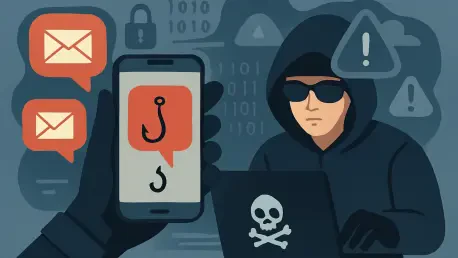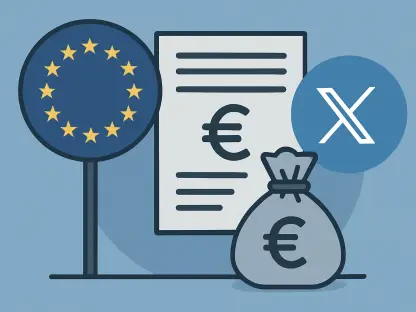In a striking escalation of the fight against cybercrime, Google has initiated a high-stakes lawsuit targeting a sprawling Chinese-based SMS phishing operation known as the Smishing Triad, marking a pivotal moment in the battle against digital fraud. Filed on November 12 in the Southern District of New York, this legal action seeks to disrupt a network of 25 unidentified individuals, labeled as “John Doe” defendants, who are allegedly behind a sophisticated phishing tool called Lighthouse. This kit has powered widespread SMS phishing attacks, often referred to as “smishing,” impacting mobile users across the globe. The operation’s vast reach, affecting over a million victims in 120 countries, underscores the urgent need for robust countermeasures. By impersonating trusted entities through deceptive text messages, these scams aim to steal sensitive payment data, often linking it to mobile wallets like Apple Pay or Google Pay for unauthorized transactions. This case not only highlights the scale of modern cyber threats but also positions Google at the forefront of a critical effort to curb such pervasive fraud.
Unmasking a Global Cyber Threat
The sheer scale of the Smishing Triad’s operation reveals a chilling reality about the state of cybersecurity today, where SMS phishing has become a weapon of choice for cybercriminals aiming to exploit unsuspecting mobile users. These attacks typically begin with fraudulent text messages that mimic communications from reputable organizations such as the U.S. Postal Service, major banks, or popular e-commerce platforms. Victims are lured into clicking malicious links, which lead to fake websites designed to capture payment card details. Once obtained, this information is often used to enroll cards into mobile wallets controlled by the scammers, enabling unauthorized transactions. The impact is staggering, with over a million individuals across 120 countries falling prey to these schemes. This global reach demonstrates how digital borders are irrelevant to cybercriminals, necessitating a coordinated international response to mitigate such widespread harm and protect vulnerable users from financial devastation.
Beyond the immediate financial losses, the psychological toll of these scams on victims adds another layer of concern, as trust in legitimate communications erodes with each successful attack. The Smishing Triad capitalizes on this trust by crafting messages that appear urgent or authentic, often prompting immediate action without scrutiny. For instance, a text claiming a package delivery issue or an account security alert can easily deceive even cautious individuals into divulging sensitive data. The aftermath often involves not just monetary theft but also the hassle of reclaiming stolen identities or funds, a process that can take months or even years. This persistent threat underscores the importance of public awareness campaigns alongside legal actions to educate users on recognizing phishing attempts. As mobile devices remain integral to daily life, the vulnerability to SMS-based fraud continues to grow, making it imperative to address both the technical and human elements of these cybercrimes to prevent further exploitation.
Inside the Lighthouse Phishing Kit
At the heart of the Smishing Triad’s operation lies the Lighthouse phishing kit, a disturbingly sophisticated tool that democratizes cybercrime by making it accessible to even those with minimal technical expertise. This kit offers over 600 customizable templates that spoof more than 400 well-known entities, including a significant number that misuse Google’s own logos, directly violating trademark rights. Its user-friendly design allows scammers to automate the mass distribution of deceptive text messages and create convincing fake e-commerce websites with ease. This turnkey solution represents a dangerous evolution in phishing technology, enabling industrial-scale attacks that exploit user trust on an unprecedented level. The ability to mimic trusted brands so effectively poses a formidable challenge to cybersecurity defenses, as distinguishing between legitimate and fraudulent communications becomes increasingly difficult for the average person.
The rise of phishing-as-a-service models, exemplified by Lighthouse, signals a troubling trend where cybercrime tools are packaged and sold to a broad audience of potential scammers, amplifying the threat landscape. This accessibility means that even novice criminals can launch sophisticated attacks without needing advanced coding skills or infrastructure. Security experts have noted that such models significantly increase the volume and impact of phishing campaigns worldwide, as the barrier to entry is drastically lowered. The Lighthouse kit’s adaptability—constantly updating templates to reflect current events or popular brands—further complicates efforts to detect and block these scams. This dynamic nature ensures that the tool remains relevant and effective, evading traditional security measures. As a result, the cybersecurity community faces an uphill battle in developing proactive strategies to counteract these readily available, highly adaptable tools that fuel global fraud networks.
Structure of a Criminal Network
The Smishing Triad operates as a highly organized criminal enterprise, with a clear division of labor that enhances its efficiency and resilience against disruption. This network comprises various specialized groups, each playing a critical role in the phishing ecosystem. Developers design and update the Lighthouse software, ensuring its effectiveness, while data brokers compile and sell lists of potential targets. Spammers handle the distribution of fraudulent SMS messages, reaching vast numbers of victims, whereas theft groups focus on monetizing stolen data through unauthorized transactions. Administrative teams oversee operations, managing online communities on platforms like Telegram for recruitment and support. This collaborative structure mirrors a corporate hierarchy, making the operation incredibly difficult to dismantle as each component can function independently if others are compromised, highlighting the sophistication of modern cybercrime networks.
The interdependence within the Smishing Triad also reveals the global nature of cybercrime, where actors from different regions and backgrounds unite for profit, often shielded by jurisdictional complexities. This setup allows the network to quickly adapt to setbacks, such as replacing a disrupted spammer group or shifting to new hosting services if domains are taken down. Such resilience poses significant challenges for law enforcement and corporations attempting to curb these activities. The use of encrypted communication channels and anonymous online platforms further obscures the identities of key players, complicating efforts to trace and apprehend them. As a result, targeting the entire enterprise rather than individual components becomes essential for meaningful impact. This intricate organization underscores why isolated actions often fail to deliver lasting results, pushing for a more holistic approach to disrupt the interconnected web of cybercriminals driving these phishing operations.
Adapting Tactics for Greater Deception
Phishing tactics employed by the Smishing Triad have evolved significantly, moving beyond simple SMS lures to more deceptive and persistent methods that evade detection. One prominent strategy involves creating fake e-commerce websites, which are often promoted through legitimate advertising platforms like Google Ads. These sites, frequently paid for with stolen credit cards, mimic real online stores and trick users into making purchases for goods they will never receive. Unlike typical phishing pages that are quickly flagged and removed, these fraudulent websites have greater staying power due to their polished appearance and integration into trusted ad networks. This shift in approach demonstrates how cybercriminals continuously refine their methods to exploit gaps in digital security, posing new challenges for platforms and users alike in identifying and mitigating these sophisticated scams.
Another alarming tactic is the exploitation of psychological triggers to increase the success rate of these phishing attempts, ensuring that victims act without hesitation against their better judgment. Messages often create a sense of urgency—claiming an account is compromised or a payment is overdue—prompting immediate clicks on malicious links. Additionally, the use of personalized data, likely obtained from data brokers, makes these communications appear more credible, as they might reference specific user details or recent transactions. This level of customization heightens the risk, as even tech-savvy individuals can be deceived by seemingly legitimate alerts. The persistent nature of these evolved tactics, combined with their ability to blend into everyday digital interactions, calls for enhanced detection algorithms and user education to combat the growing subtlety of phishing scams. Without such measures, the Smishing Triad and similar groups will continue to exploit human vulnerabilities with devastating effectiveness.
Legal Arsenal Against Cyber Fraud
Google’s legal strategy in this lawsuit represents a calculated effort to strike at the core of the Smishing Triad by treating it as a unified criminal enterprise rather than a collection of isolated actors. Utilizing the Racketeer Influenced and Corrupt Organizations (RICO) Act, the suit aims to hold the network accountable for its coordinated activities, focusing on the systemic nature of the fraud. Additionally, the unauthorized use of Google’s branding in phishing templates provides grounds for trademark infringement claims, strengthening the case. The primary goal is to unmask the anonymous “John Doe” defendants and disrupt their operations, while also setting a legal precedent for how corporations can combat organized cybercrime. This approach signals a shift toward more aggressive corporate involvement in cybersecurity, potentially inspiring other companies to pursue similar actions against digital threats.
Another critical aspect of Google’s legal maneuver is the pressure it places on Chinese hosting providers, such as Tencent and Alibaba, to take responsibility for phishing domains hosted on their platforms. By implicating these third parties, the lawsuit seeks to enforce accountability, urging them to shut down identified malicious sites. While this could introduce a significant disruption to the Smishing Triad’s infrastructure, the long-term efficacy of such measures remains uncertain due to the adaptability of cybercriminals and varying international legal standards. Nonetheless, this tactic highlights the importance of targeting the enabling ecosystem of cybercrime, beyond just the perpetrators themselves. If successful, it could reshape how hosting services approach their role in preventing digital fraud, potentially leading to stricter oversight and faster responses to reported threats, thereby narrowing the operational space for phishing networks globally.
Future Hurdles in Cybersecurity Battles
Despite the potential for Google’s lawsuit to disrupt the Smishing Triad, security experts like Ford Merrill from SecAlliance warn that such legal actions may only offer temporary relief in the broader fight against cybercrime. The Chinese phishing market, estimated to involve tens of thousands of participants, is driven by immense profitability, incentivizing operators to rebrand or rebuild under new identities after setbacks. This adaptability reflects a persistent cat-and-mouse dynamic between law enforcement, corporations, and cybercriminals, where each disruption is met with rapid reinvention. The vast scale and lucrative nature of these operations suggest that isolated lawsuits, while impactful in the short term, are unlikely to eradicate the threat entirely, pointing to the need for more comprehensive strategies to address the root causes of digital fraud.
Addressing these challenges requires a multifaceted approach that extends beyond legal battles to include international cooperation and innovative technological defenses against evolving phishing tactics. Governments, corporations, and cybersecurity firms must collaborate to share intelligence, standardize regulations, and develop advanced tools to detect and block malicious activities in real time. Equally important is the role of user education in building resilience against SMS phishing, as informed individuals are less likely to fall victim to deceptive messages. Investing in global frameworks to increase the operational costs for cybercriminals—through stricter penalties, faster domain takedowns, and disrupted payment channels—could deter future scams. As the digital landscape continues to evolve, sustained efforts to outpace cybercriminal innovation will be crucial in safeguarding mobile users and maintaining trust in digital communications worldwide.









